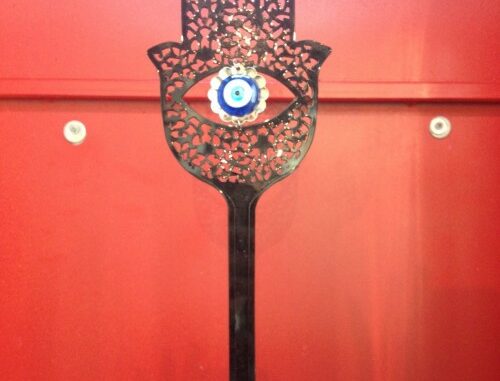
Young amateurs from Saudi Arabia, green but buzzing with energy, showcase a range of eclectic works impossible to lump together in one neat category. This rebellious and chaotic variety is, to a large extent, the event’s charm.
At the 2012 edition of Young Saudi Artists, the 44 works by 23 artists scanned subjects that varied from deeply personal to socially and politically engaged, and the skill level varied from rudimentary to promising. They came in different shades of appeal: eye-catching, decorative, lyrical, thought-provoking and visually stunning. As works of art, they negotiate the harmony between form and message sometimes quite seamlessly, and at other times, a little too simplistically or awkwardly. However, this is not an event for the punctilious critic who gloats in pointing out deficiencies, it’s an event for the believer who is excited by the idea of germination, and who sees the promise more than the flaw.
For most of these 23 participants, art is a passion, something that they do despite themselves. For the moment, they pursue it as a strong side-activity, in addition to more consuming studies or jobs. Some of them have already found a niche for work that blends their passion with financial returns, and some of them continue to juggle the two, while dreaming up their paths and destinies.

Lujain Abulfaraj is a Saudi who has been residing outside the Kingdom in neighbouring Gulf states for the past 15 years. Along with Ahaad Al Amoudi (work described below), she won a competition called Youth Hajj organized by Offscreen Expeditions, an independent cultural dialogue initiative based in England and active in Saudi Arabia since a couple of years. She won a trip to Saudi Arabia with a group of diverse, multi-cultural youngsters who won from other countries. Only recently, she launched her own interactive art and design magazine. Although away from her country, she gets to visit very often, and the spiritual symbolism of Saudi Arabia’s best-known centres of Mecca and Medina runs like a melody through her pink-bled series that she displays at this year’s Young Saudi Artists. With a mother from Mecca and a father from Medina, a sense of deep spirituality defines her being and her work, a spirituality which is perhaps closer to the heart of all religions rather than just Islam. If anything, it’s the mysticism of the words from a Hadith (‘La farqa bain arbi wa la ajmi ilaa bil taqwaa’ ‘There is no difference between an Arab and a non-Arab except in faith’ which is also the title of the work) combined with a sense of slow motion that the series exudes which makes her work one of pure magic. It portrays groups of people (back views and profile views) at different stages in the ritual of worship (some performing ablution with the water of zamzam, some at a point in the circumambulation of the kaa’ba, some at the entrance to the Masjid Nabwi in Medina). The scene of a congregation at the Kaaba, with its millions drawn like fireflies to a common centre of light, and uniting over and above their differences in a common act of faith and seeking is the most poignant and poetic visual metaphor for the spirit of unity, equality, and brotherhood which is the cornerstone of Islam. It is this magical encounter with this over-powering, larger-than-life force visually accessible to the frequent visitor to the Holy cities that is one of her most active and nourishing memories, the force that energizes her and what she attempts to capture in this poetical work.
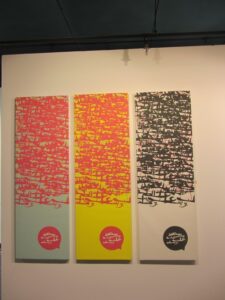
Bound to the first work by a sister shade of pink, Mohammed Naseem’s charming triptych is called ‘Seen wa Suaad’ (‘Seen and Su’aad’. Seen and su’aad are Arabic alphabets combining an emphatic ‘s’ sound followed by a prolonged vowel sound). The base of the canvas is a speech bubble with ‘Muhammad…’ written inside, and a certain space upwards of it is a cloud with a clutter of letters. When a Muslim utters the name of the Holy Prophet, it is incumbent on the listeners or the other members of the audience to say ‘Peace be upon him’ as a sign of respect. In a gathering, when a whole crowd of people utters it, it sounds like an endless murmur, falling and rising several times before its end. All we hear out of the whole string of letters is the ‘seen’ and ‘suaad’, like one prolonged and continuous lisp drawn out in several tiny waves. The comic-strip like composition, the bubble-gum mish colours of fluorescent pink and yellow, and the jumbled scrawl of overlapping Arabic script on the top point light-heartedly to the comical underside of quotidian and internalized details that routinely escapes us.
Ahaad Al Amoodi’s work is centred around Balad, an area called the heart of Jeddah. Balad is the ‘old city’, the earliest settling zone, which has now been slowly pushed to the south, as urbanization continues to stretch the city’s periphery further and further to the north. The cluster of houses in this once-elite region bear names that are familiar today as belonging to the city’s most successful and well-known families, best-known for the industries, trades and businesses they own. Their family homes, once bustling with life and housing several generations under one roof, are now reduced to empty shells. The art work comprises of two framed etchings of facades from Balad, which are instantly recognizable to any Jeddah resident, having almost become a symbol for lost heritage. In front of these etchings is an installation, which looks like an upward-spiraling embrace of stick-like limbs of wood and steel. It took me a visit to Balad to appreciate the full impact of the skeletal erection in which the precariousness of wood is supported by the sturdiness of steel. The houses in Balad are several storey high with fronts of latticed wood, moist with decay and hollowed by age, as frail as cardboard from a theatre set, and look ready to crumble at the blow of a breath. Mere vestiges remain, flimsy as filigree, and the abandoned zones, now occupied by squatters and illegal occupants, mostly labourers unable to afford decent housing, are a rude caricature of its former glory. Some say that some old people have been abandoned here to neglect and a sad end. Empty houses attract ghosts as much as ghost stories; with the air of mystique that hangs heavy on the houses, one can no longer tell fact from fiction. Some façades were devoured by fierce fires that blazed through the region in 2009, and one can still see the charred cheek of concrete where the tongue of fire licked it. It has a deeply sleepy mood to it, and one can’t help but wonder if the slumber that hangs heavy on the region is the lull before a final passing out. Perhaps the only question that remains is how long. Ahaad’s work poses a screaming question about the end of abandoned heritage and points to how new materials, appropriation, and imagination can sustain heritage.
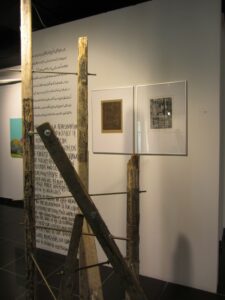
What Heba Abed’s clumsily christened ‘Fraco-Arabic Man of Scotoma’ loses in grace of name, it makes up for in intent. Franco-Arabic is the popular chat Arabic, a Latin transcription of Arabic. ‘Scotoma’ is greek for blind-spot. Heba suggests that the progressive linguistic simplification, the digitalization and the modernization of Arabic might lead to a linguistic and existential blind-spot. Her message is encased in an engaging form that tickles the sense of touch. Between two rods of steel, she uses the form of the abacus to echo her message. On one side, the revolving squares have three layers of text embedded in them, a big and a small font in Arabic and one in Latin. The surface of the squares is reflective, so that we catch a quick glimmer of the scripts in light, but as soon as one struggles to focus on the message, one is unable to rest the eye serenely or surely on any one of the scripts we see reflected, they disappear before the retina can imprint them. Super-imposed upon this surface of square (sub-divided into keyboard like buttons) is something of a unisex human form. The message here is that as we dilute language, we lose the flavour and uniqueness of our identity, and become neutralized, homogenized humanoids, something like the human version of MacDonald’s. On the other face of the abacus, in clear, readable, script are messages that reaffirm the valour and the history of the Arabic language, referring to different historical epochs and the cultural shades that coloured the language at certain epochs.
Twenty-three year old Soraya Darwish, is Egyptian and is exhibiting for the very first time in Saudi Arabia, a country where she has lived all her life. Her first break as an artist came some months ago, when she displayed at the Ara Gallery in Dubai. She is the creator of two alternative art resources in Jeddah, a blog about art and design, and a series of informal get-togethers and discussions about art, both among the first in the region. Like several of her fellow participants, even before this first official break became available to her, her engagement with art was active. It is not a secret that in Saudi Arabia, parallel and underground resources and initiatives often wield more power and results than ‘official’ and established resources. The ‘contemporary Saudi art movement’, as it is coming to be called, itself emerged as an underground wave whose accumulative positive energy has become a force to reckon with today, and will mould the destiny of so many people differently than anyone could ever have imagined. Soraya belongs to the significant expat community of non-Saudi Arabs who have grown up almost entirely in Saudi Arabia, and merge their native culture and the adopted Saudi culture in an interesting blend. Her work, however, transcends these distinctions and applies to the whole Arab belt, if not every man who has been falsely stereotyped. It is ironically titled ‘Nice to meet you’ and instead of a scene of social politesse as one would expect to see, the central piece features a digital print of a young Arab girl holding a gun straight at the viewer. It is displayed in a small square zone with walls on three sides and spaced pillars on the fourth. We first see the pillars and the text on them stating clips from newspapers and media dismissively presenting Arabs and Muslims as terrorists, using the swaying rhetoric of facile and unwarranted statistics for thrust. In the dark corner, peering through the black pillars, the girl with the gun almost forbids us to enter. When we enter, to the right, on a wall-sized screen, is a video screen with a clip on repeat, of which we only register a woman in burqaa holding a rifle and shooting blindly skywards in a street, where soon after, panic ensues and people scamper about for life. The darkness of the messages predisposes us to a mindset in which we only see the violent; every human seems like a murderer and every flickering object a fire-arm. It takes some settling time for the mind to decipher that alternating with images of the woman and gun fire in the video clip are shots of ordinary girls sitting in a café and laughing over a blazing candle from a birthday cake. These girls are the artist and her friends. They are clad in abbayas, as was the shooting woman, and in the mind’s initial panicked state, the candle seems like another explosive until reason settles the vision and allows for distinction. Similarly, as we draw closer to the still of the demon-girl, we see embedded within the pixels of the image small images of ordinary people, family life, children, and scenes from everyday. And once we have seen those smaller, truer molecules of being, close-up, when we distance ourselves from the image, it doesn’t scare any more, and we leave cleansed in mind and heart. Over the 20 days of the exhibition, the pillared wall was used as a public scribble zone and the audience participated by writing messages on the walls. When I went the last day, there was enough love on the walls to drown out the hate of media half-truths. Soraya’s work is like an exercise in corrective perception; we enter in darkness, and squint our way to light and vision.
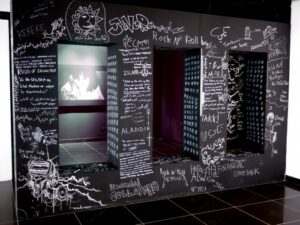
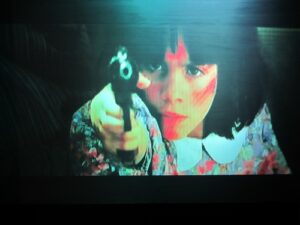
Another art work became an exhibition icon because as luck would have it, the strangeness of truth it absorbed became truer than the strangeness of fiction it portrayed. In an uncanny but delicious twist of faith, the message that the artwork embodied was acted out in real life itself, making it that alluring alloy of truth, fiction, and great timing that secures its reputation in memory. The work in question is by Basmah Felemban, a 16-year old high-school graduate taking a break to ‘find her groove’. It contains the symbol of the healing hand of Fatima, a three-fingered hand with a thumb on each side, in the shape of a fly-swatter. This symbol, like a decorative object, is encased inside a red emergency box with a transparent glass door that usually houses a fire extinguisher. A line reads, ‘In case of an emergency, break the glass.’ In popular culture, this amulet is believed to prevent against the curse of the evil eye of the ill-wisher who, merely by beholding something enviously, causes harm. The Arabs, like Asians, are inherently superstitious people, and believe in the power of symbol. In daily conduct, handling and dealing of situations, their natural bent of wisdom favours a more spiritual approach rather than a coldly rational one. However, Basmah feels that sometimes, the leniency of a spiritual interpretation of events degenerates into a posture of convenient escapism, and we use it to find an easy exit from situations and problems. Over time, this moral laziness hardens into habit, and we habitually overlook reasonable, rational explanations for phenomenon and make our way out without self-accountability. The amulet enclosed in the emergency box, the ‘khamsa’ (meaning ‘five’, which is the count of fingers on the hand) is believed to protect against the ‘curse of the evil eye’, a curse of ill-luck set into motion by the envious look of a rival. For example, if someone’s child falls ill, instead of analyzing reasons which might involve personal neglect, question their parenting practices or beg for reform, they could conveniently say that someone gave them the evil eye and attribute the blame to another person. This way, they’re not only shutting out responsibility but also the learning that comes from facing discomfort. Basmah’s claim to a rational rather than a superstitious (and responsible, rather than escapist) reading of things was put to a slippery test, when minutes before the actual exhibition, the glass from the door of the exhibit broke without anyone tampering or as much as touching it. Although devastated, she looked past the scores of people telling her that some jealous competitor had given her the evil eye. The glass was replaced, but it broke a second time, shortly after the replacement. She was ‘lucky’ the third time round, but her luck stayed put only because her salvation was reason. The second accident forced her to delve into the possible reasons for the repeated breaking, and she discovered that the frame holding the glass in place was crooked, which disturbed its balance to breaking-point. A logical solution was plexiglass, and it has stayed in place since. ‘Luck’ or ‘ill-luck’, then, was merely physics, when looked up close.
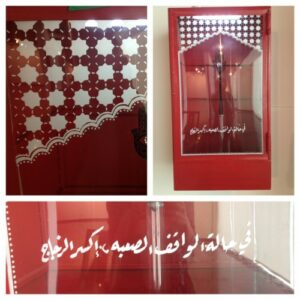
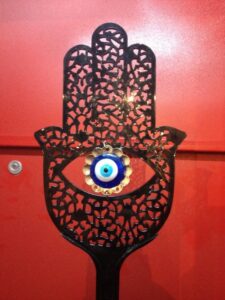
How does one sum up the common narrative of the show? I’m afraid there is none, except the narrative of a will, belief and the readiness to participate. Any responsible appraisal that has the courage to be more hopeful than condescending, more optimistic than realistic, and that speaks from a standpoint of regard for local culture rather than lip-synching to fashionable opinion imports and most importantly, one that understands first-hand the challenges of being an artist, a curator, or an agent of change in Saudi Arabia will agree that it really is the most important narrative of all – the will to be part a significant change, no matter how small, the belief to keep doing it, year after year, and the readiness to be there against all odds.
Adapted from a write-up originally published on Jeddah Blog. (Link here https://jeddahblog.livejournal.com/74479.html)

Leave a Reply